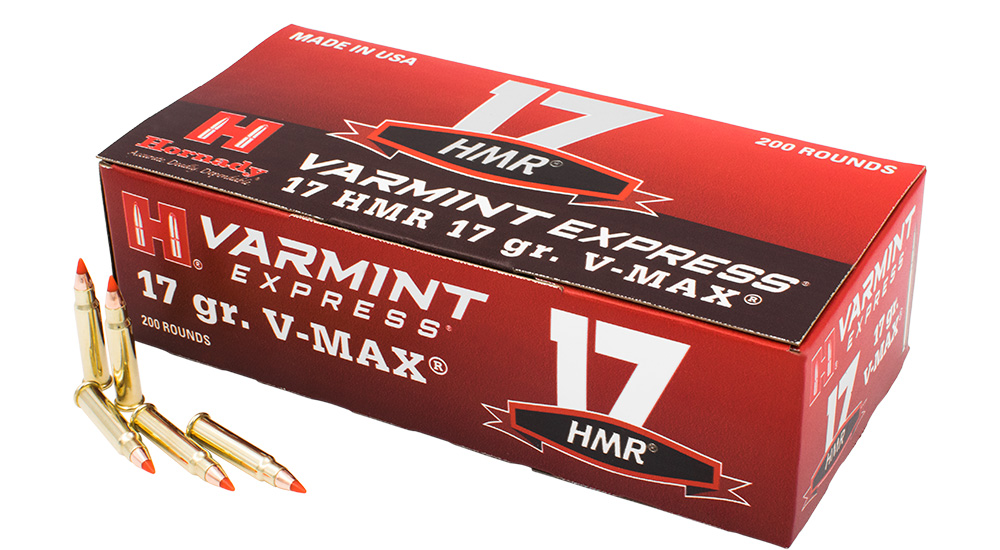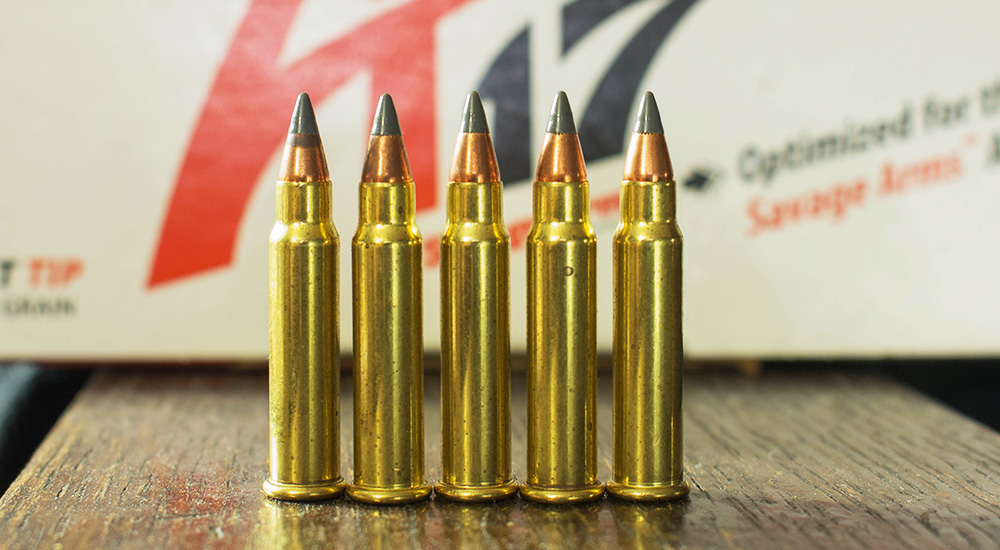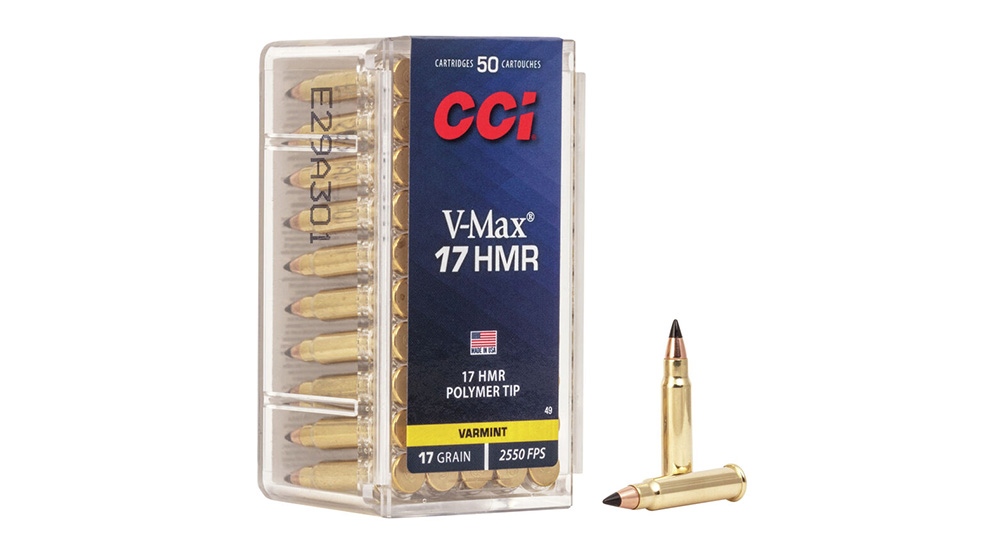The Rosebud Reservation of South Dakota is a beautiful and unique landscape, rife with game—the whitetail and mule deer are fantastic—and with its own cultural history. It is also riddled with prairie dogs. Any fan of high-volume shooting should have the opportunity to sit over a hot prairie dog town at least once, with a good rifle and an obscene amount of ammunition. Such was the case one June weekend, when I had the opportunity to test all sorts of varmint rifles and ammunition. While I have my tried-and-true favorites—the .22-250 Remington is absolutely devastating on prairie dogs—I gained a new appreciation for using rimfire cartridges at longer ranges, and none more than the .17 Hornady Magnum Rimfire.

The .17-caliber cartridges date back to the mid-20th century in wildcat form (P.O. Ackley was a fan), and to 1971 in the form of the .17 Remington. Released in 2002, the .17 Hornady Magnum Rimfire (commonly abbreviated as .17 HMR) is based on the .22 Winchester Magnum Rimfire, necked down to hold 0.172-inch diameter bullets. Invariably, the .22 rimfires still rule the roost, what with the uber-popular .22 Long Rifle, and its older siblings the .22 Short and .22 Long, and the younger .22 Magnum. However, experiments had been made in sub-.22 caliber cartridges, namely the short-lived 5mm Remington Rimfire Magnum, released in 1969.
Hornady’s dive into a .17-caliber rimfire was met with fanfare, as it truly was—and still is—a decided improvement over the long-range ballistics of any of the .22 rimfire cartridges. Where the .22 WMR is a straight-walled, rimmed case, the .17 HMR retains the rim (of the same diameter as its parent), but uses a 25-degree shoulder to step the case down to hold the smaller diameter bullets. It uses a slightly longer case length at 1.058 inches, yet the same overall length at 1.349 inches. These common dimensions assure bolt faces and magazines are interchangeable between the cartridges.
The .17 HMR offers a lighter bullet than does any of the .22 rimfires, with weights ranging from 15.5 grains up to 20 grains, with the middle-of-the-road 17-grain loads being very popular. In the velocity department, the .17 HMR picks up where the .22 WMR leaves off, albeit with much lighter projectiles. The 20-grain loads run at 2375 fps, the 17-grain loads run between 2530 and 2650 fps and those light little 15.5-grain bullets will leave the muzzle at 2525 fps. With very little recoil, if any, the .17 HMR gives the shooter/hunter the ability to hit small targets at distances considered beyond the realm of the .22 LR, and possibly the .22 WMR, and deliver enough energy to handle not only rabbits, squirrels and other small game animals, but foxes, coyotes and other predators as well.

How does the .17 HMR stack up against other rimfires? Out on that prairie dog shoot in South Dakota it compared very favorably to the .22 LR and .22 WMR both, as it not only offered a flatter trajectory, but was much easier to shoot in windy conditions. Dealing with trajectory first, I’d like to compare the common Hornady 17-grain load for the .17 HMR with the sleek and speedier 30-grain .22 WMR load. Both loads can be zeroed at 100 yards, with the .17 HMR having a mid-rise 0.3 inches, and the .22 Mag of 0.7 inches. It is past the 100-yard mark that the .17 HMR pulls away from the .22 Mag., essentially cutting the holdover in half. At 125 yards, the .17 will drop 0.9 inches compared to the .22 Mag’s 1.8 inches, and at 150 yards the gap widens, with the cartridges dropping 2.6 inches and 4.8 inches, respectively. Were you to take the pair to 200 yards, you’d see the .17 HMR strike 8.5 inches low, while that snappy Hornady load for the .22 WMR will drop 15.7 inches. This advantage might not be initially evident to many squirrel and rabbit hunters, but for those who like to pursue coyotes with a rimfire rifle, it can make difference.
It was the performance in the wind sealed the deal for me, and that among the rimfire cartridges, only the .17 WSM fared better. At 100 yards, in a 10-mph crosswind, the .17 will drift 3.3 inches compared to the .22 Mag.’s 5.7 inches; at 150 it is 8.0 inches compared to 13.9, and at 200 yards it’s 15.4 inches for the .17 HMR and 25.9 inches for the .22 Mag. That wind can gust much harder than that in Wyoming, and the .17 HMR seemed to cut the adjustment for wind deflection in nearly half.
While the .17 HMR is surely effective out to 150 or 175 yards, it does come at a cost, and that is, well, the cost of the ammo. Street prices as of the time of this writing run about $0.35/round – about the same as the cost of ammo for the .22 WMR – being much more expensive than the .22 Long Rifle, which runs between $0.08 and $0.14/round. But, if you want to use a light-caliber rimfire at longer distances, that is the price you’ll have to pay. The only other caveat I will bring up is that the .17-caliber barrels tend to foul quickly, and definitely shoot best when clean. You’ll need a specialized cleaning rod for that chore, and specific patches cut to a proper size to avoid jamming in the rifling.

There are plenty of good choices among the factory ammo, including the Hornady Varmint Express Rimfire trio of the 15.5-grain NTX lead free bullet at 2525 fps, the 17-grain V-Max at 2550 fps and the 20-grain XTP at 2,375 fps. Remington offers the 17-grain jacketed hollow-point and AccuTip-V bullets at 2550 fps and a 20-grain JHP at 2375 fps. Federal has two loads in its Varmint & Predator line—the 17-grain V-Max and the 17-grain Speer TNT at 2530 fps; while CCI has the 20-grain GamePoint and FMJ loads at 2375 fps, the 17-grain TNT as 2,550 fps and the screaming A17 load, featuring the 17-grain Varmint Tip at 2650 fps. Winchester also loads a couple of the Hornady bullets—the 17-grain V-Max, the 15.5-grain NTX and the 17-grain XTP—and its sister company Browning loads their 17-grain Polymer Tip bullet in its BPR ammo line.
Do you need a .17 HMR if you’ve already got a good .22 LR? I feel that “need” is subjective, and that if you want a rimfire for extended shooting ranges, the .17 HMR is a damned good fit. Yes, the .17 Winchester Super Magnum is faster, and offers a bit more bullet weight—running up to 25 grains—but the choice of rifles is much more limited. I like the .17 HMR, both as an all-around rimfire cartridge, and in addition to the .22 Long Rifle in my rifle lineup.
Looking for previous installments of our “Behind the Bullet” series? We’ve got you covered.• 6.5 Weatherby RPM• .327 Federal Magnum• .450 Bushmaster• 7mm PRC• .275 Rigby• .340 Weatherby Magnum• .416 Ruger• 27 Nosler• .257 Roberts• 7mm Weatherby Magnum• .300 PRC• .350 Rigby Magnum• .450 Nitro Express• .17 Hornet• 7mm STW• 6.8 Western• .375 Ruger• .223 Remington• 6.5×55 Swedish• .416 Remington Magnum• .300 Winchester Short Magnum• 28 Nosler• 6.5 PRC• .22 WMR• .458 Winchester Magnum• .22 Hornet• .280 Ackley Improved• .240 Weatherby Magnum• .458 Lott• .264 Winchester Magnum• .348 Winchester• .33 Nosler• .260 Remington• .30-30 Winchester• .416 Rigby• .358 Norma Magnum• .22 LR• 7mm-08 Remington• 8mm Remington Magnum• .338 Federal• .224 Valkyrie• .338-06 A-Square• 9.3x62mm Mauser• .257 Weatherby Magnum• .45-70 Government• .300 H&H Magnum• .25-06 Remington • .30-06 Springfield• 6.5 Creedmoor• .300 Remington Ultra Magnum• 7mm Remington Magnum• .470 Nitro Express• .280 Remington• .300 Winchester Magnum• .270 Winchester• .222 Remington• .45 ACP• .404 Jeffery• .44 Remington Magnum • .41 Remington Magnum• .243 Winchester• .338 Winchester Magnum• .357 S&W Magnum• 6.5-284 Norma• 8×57 Mauser• .38 Smith & Wesson Special• 7x57mm Mauser• 9mm Luger• .35 Whelen• .454 Casull• .375 H&H Magnum• .45 Colt• .22-250 Remington• 10mm Auto• .308 Winchester









